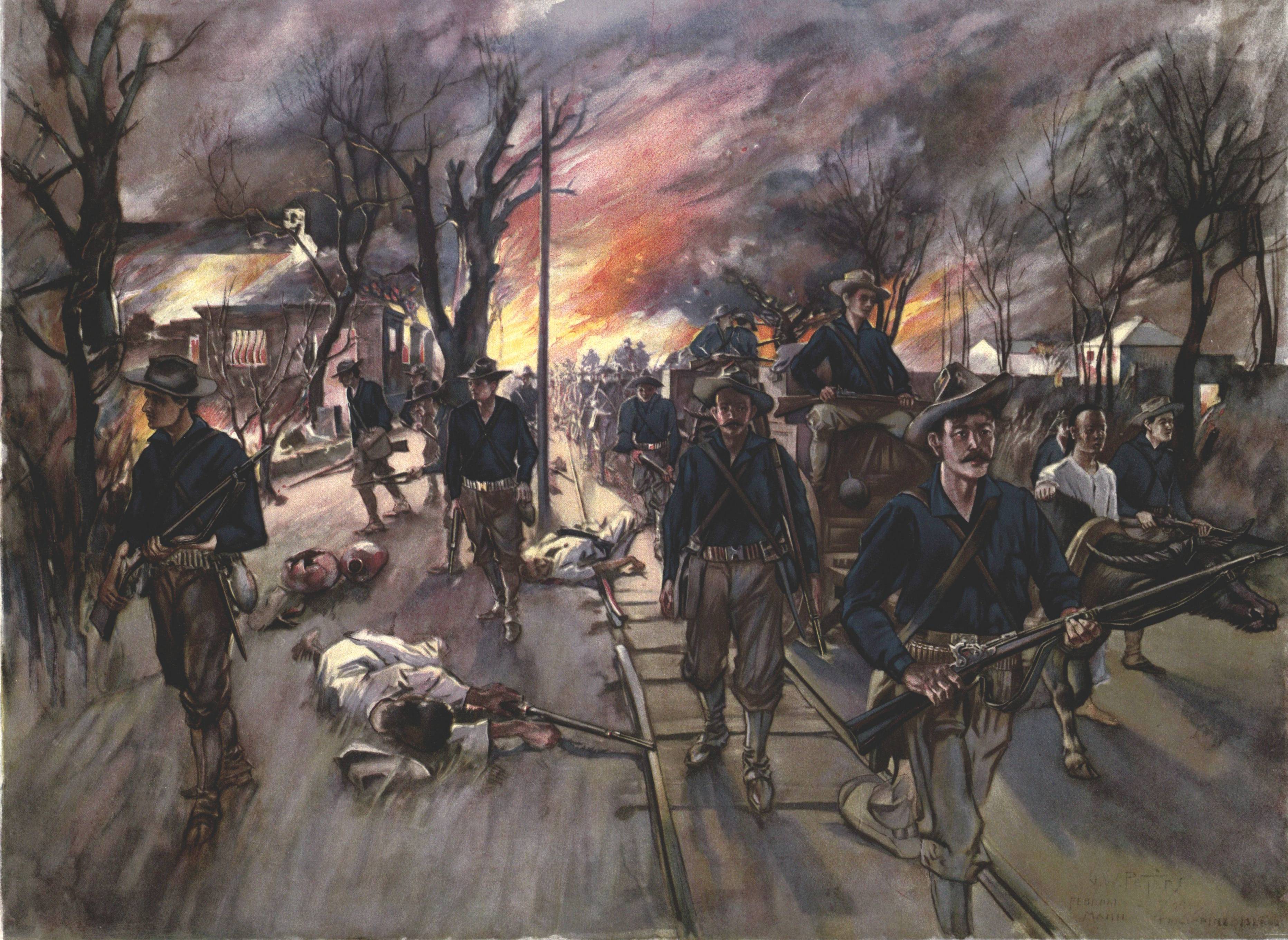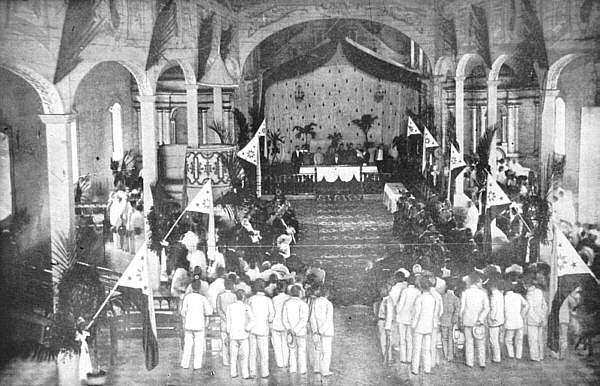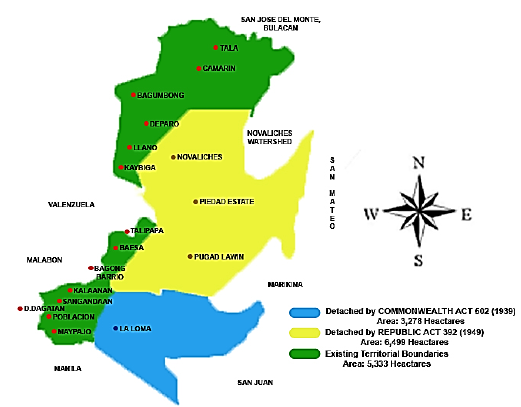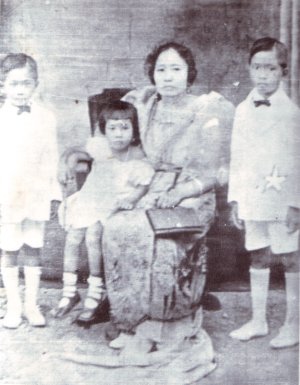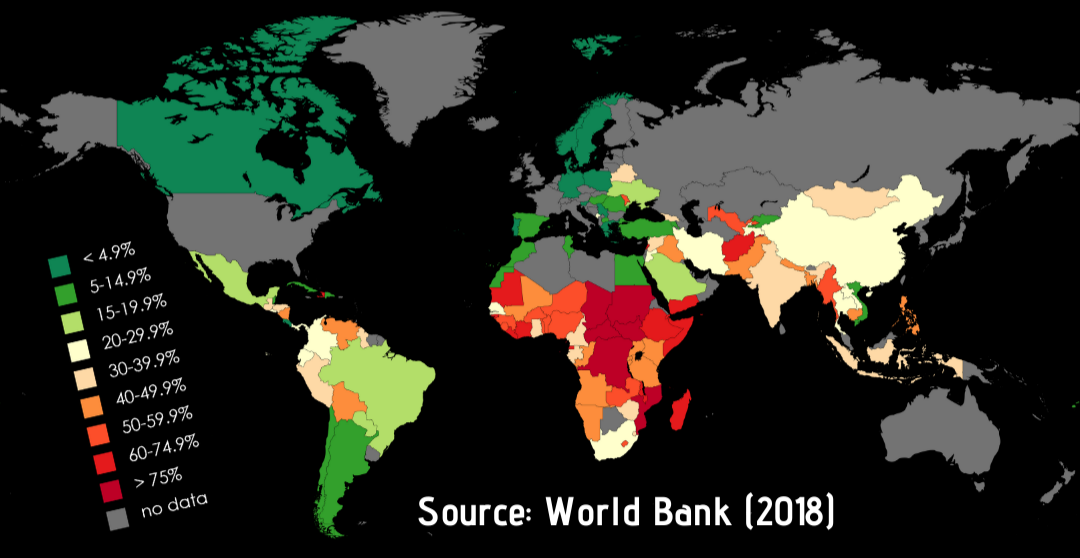|
Bagong Silang
Bagong Silang or Barangay 176 is a barangay of Caloocan, Metro Manila, Philippines. It is known for being the most populous barangay in the Philippines, with a population of 261,729 according to the 2020 census. It is also the northernmost barangay of Metro Manila located in the northern section of the city bordering the province of Bulacan. History The barangay occupies parts of land originally of Tala Estate, which is historically under the jurisdiction of the town of Novaliches before it was absorbed by Caloocan in 1903. The estate was reserved and acquired by the government in 1938 primarily for a leprosarium, which turned out to be the Central Luzon Sanitarium (present-day Dr. Jose N. Rodriguez Memorial Hospital); however, only one-third of the land was used for such purpose. Due to advancements in medical science that no longer requires the segregation of hansenites, the leprosarium needed lesser land area, paving the way for housing and urban development in the area. T ... [...More Info...] [...Related Items...] OR: [Wikipedia] [Google] [Baidu] |
Barangay
A barangay (; abbreviated as Brgy. or Bgy.), historically referred to as barrio (abbreviated as Bo.), is the smallest administrative division in the Philippines and is the native Filipino term for a village, district, or ward. In metropolitan areas, the term often refers to an inner city neighborhood, a suburb, or a suburban neighborhood or even a borough. The word ''barangay'' originated from '' balangay'', a type of boat used by a group of Austronesian peoples when they migrated to the Philippines. Municipalities and cities in the Philippines are politically subdivided into barangays, with the exception of the municipalities of Adams in Ilocos Norte and Kalayaan in Palawan, with each containing a single barangay. Barangays are sometimes informally subdivided into smaller areas called ''purok'' ( en, " zone"), or barangay zones consisting of a cluster of houses for organizational purposes, and '' sitios'', which are territorial enclaves—usually rural—far from th ... [...More Info...] [...Related Items...] OR: [Wikipedia] [Google] [Baidu] |
Philippines
The Philippines (; fil, Pilipinas, links=no), officially the Republic of the Philippines ( fil, Republika ng Pilipinas, links=no), * bik, Republika kan Filipinas * ceb, Republika sa Pilipinas * cbk, República de Filipinas * hil, Republika sang Filipinas * ibg, Republika nat Filipinas * ilo, Republika ti Filipinas * ivv, Republika nu Filipinas * pam, Republika ning Filipinas * krj, Republika kang Pilipinas * mdh, Republika nu Pilipinas * mrw, Republika a Pilipinas * pag, Republika na Filipinas * xsb, Republika nin Pilipinas * sgd, Republika nan Pilipinas * tgl, Republika ng Pilipinas * tsg, Republika sin Pilipinas * war, Republika han Pilipinas * yka, Republika si Pilipinas In the recognized optional languages of the Philippines: * es, República de las Filipinas * ar, جمهورية الفلبين, Jumhūriyyat al-Filibbīn is an archipelagic state, archipelagic country in Southeast Asia. It is situated in the western Pacific Ocean and consists of aro ... [...More Info...] [...Related Items...] OR: [Wikipedia] [Google] [Baidu] |
Metro Manila
Metropolitan Manila (often shortened as Metro Manila; fil, Kalakhang Maynila), officially the National Capital Region (NCR; fil, link=no, Pambansang Punong Rehiyon), is the capital region, seat of government and one of three List of metropolitan areas in the Philippines, defined metropolitan areas in the Philippines. It is composed of 16 Cities of the Philippines#Legal classification, highly urbanized cities: the Manila, city of Manila, Quezon City, Caloocan, Las Piñas, Makati, Malabon, Mandaluyong, Marikina, Muntinlupa, Navotas, Parañaque, Pasay, Pasig, San Juan, Metro Manila, San Juan, Taguig, and Valenzuela, Metro Manila, Valenzuela, as well as the municipality of Pateros. The region encompasses an area of and a population of as of 2020. It is the second most populous and the most densely populated Regions of the Philippines, region of the Philippines. It is also the List of metropolitan areas in Asia, 9th most populous metropolitan area in Asia and the List of larges ... [...More Info...] [...Related Items...] OR: [Wikipedia] [Google] [Baidu] |
Caloocan
Caloocan, officially the City of Caloocan ( fil, Lungsod ng Caloocan; ), is a 1st class Cities of the Philippines#Legal classification, highly urbanized city in Metropolitan Manila, Philippines. According to the 2020 census, it has a population of 1,661,584 people making it the List of cities in the Philippines, fourth-most populous city in the Philippines. Caloocan is divided into two geographical locations with a total combined area of . It was formerly part of the Rizal, Province of Rizal of the Philippines' Southern Tagalog, Southern Luzon Region. It comprises what is known as the Administrative divisions of Metro Manila#Districts, CAMANAVA area along with cities Malabon, Navotas and Valenzuela, Metro Manila, Valenzuela. South Caloocan is bordered by Manila, Quezon City, Malabon, Navotas and Valenzuela. Presence of commercial and industrial activities combined with residential areas make it a highly urbanized central business district and a major urban center in the Norther ... [...More Info...] [...Related Items...] OR: [Wikipedia] [Google] [Baidu] |
Caloocan's 1st Congressional District
Caloocan's 1st congressional district, also known as North Caloocan district, is one of the three congressional districts of the Philippines in the city of Caloocan. It has been represented in the House of Representatives of the Philippines since 1987. The district consists mostly of the North Caloocan barangays north of EDSA and Circumferential Road 4: Barangays 1 to 4 of Zone 1, Barangays 77 to 85 in Zones 7 and 8, and Barangays 132 to 177 in Zones 12 to 15 bordering the Metro Manila cities of Malabon, Quezon City (Novaliches and Lagro area), and Valenzuela as well as the Bulacan city of San Jose del Monte. It is currently represented in the 19th Congress by Oscar Malapitan of the Nacionalista Party (NP). In 2021, Barangays 178 to 188, which were part of the first district since its creation, have been separated from the district to form the third legislative district of Caloocan by virtue of Republic Act No. 11545. Representation history Election results 2022 20 ... [...More Info...] [...Related Items...] OR: [Wikipedia] [Google] [Baidu] |
Philippine Standard Time
Philippine Standard Time (PST or PhST; fil, Pamantayang Oras ng Pilipinas), also known as Philippine Time (PHT), is the official name for the time zone used in the Philippines. The country only uses one time zone, at an offset of UTC+08:00, but has used daylight saving time for brief periods in the 20th century. Geographic details Geographically, the Philippines lies and 126°34′ east of the Prime Meridian, and is physically located within the UTC+08:00 time zone. Philippine Standard Time is maintained by the Philippine Atmospheric, Geophysical and Astronomical Services Administration (PAGASA). The Philippines shares the same time zone with China, Taiwan, Hong Kong, Macau, Malaysia, Singapore, Western Australia, Brunei, Irkutsk, Central Indonesia, and most of Mongolia. History Philippine Standard Time was instituted through Batas Pambansa Blg. 8 (that defined the metric system), approved on December 2, 1978, and implemented on January 1, 1983. The Philippines is ... [...More Info...] [...Related Items...] OR: [Wikipedia] [Google] [Baidu] |
Bulacan
Bulacan, officially the Province of Bulacan ( tl, Lalawigan ng Bulacan), is a province in the Philippines located in the Central Luzon region. Its capital is the city of Malolos. Bulacan was established on August 15, 1578, and part of the Metro Luzon Urban Beltway Super Region. It has 569 barangays in 20 municipalities and four component cities (Baliuag, Malolos the provincial capital, Meycauayan, and San Jose del Monte). Bulacan is located immediately north of Metro Manila. Bordering Bulacan are the provinces of Pampanga to the west, Nueva Ecija to the north, Aurora and Quezon to the east, and Metro Manila and Rizal to the south. Bulacan also lies on the north-eastern shore of Manila Bay. In the 2020 census, Bulacan had a population of 3,708,890 people, the most populous in Central Luzon and the third most populous in the Philippines, after Cebu and Cavite. Bulacan's most populated city is San Jose del Monte, the most populated municipality is Santa Maria while the ... [...More Info...] [...Related Items...] OR: [Wikipedia] [Google] [Baidu] |
Novaliches
Novaliches is a place that forms the northern areas of Quezon City, and encompasses the whole area of North Caloocan. Etymology The name Novaliches came from the name of the small village of Novaliches in the town of Jérica, Spain. It was awarded to General Manuel Pavía y Lacy, who served as a Governor-General of the Philippines. The child Queen Isabella II bestowed on him the title "Marquez of Novaliches" for defending her against her uncle Don Carlos María Isidro Benito de Borbón, who claimed the throne of Spain which resulted in the First Carlist War. History On February 2, 1854, General Manuel Pavía y Lacy was sent to Manila to serve as the Governor-General of the Philippines. His task was to establish a penal colony where prisoners were given lands to develop in exchange for their freedom. The colony was given the name Hacienda Tala, and it eventually grew into a larger community. In the same year, the Alcalde Mayor (equivalient to present-day Governor) of ... [...More Info...] [...Related Items...] OR: [Wikipedia] [Google] [Baidu] |
Ferdinand Marcos
Ferdinand Emmanuel Edralin Marcos Sr. ( , , ; September 11, 1917 – September 28, 1989) was a Filipino politician, lawyer, dictator, and kleptocrat who was the 10th president of the Philippines from 1965 to 1986. He ruled under martial law from 1972 until 1981 p. 189. and kept most of his martial law powers until he was deposed in 1986, branding his rule as " constitutional authoritarianism" under his Kilusang Bagong Lipunan (New Society Movement). One of the most controversial leaders of the 20th century, Marcos's rule was infamous for its corruption, extravagance, and brutality. Marcos gained political success by claiming to have been the "most decorated war hero in the Philippines", but many of his claims have been found to be false, with United States Army documents describing his wartime claims as "fraudulent" and "absurd". After World War II, he became a lawyer then served in the Philippine House of Representatives from 1949 to 1959 and the Philippine Senate ... [...More Info...] [...Related Items...] OR: [Wikipedia] [Google] [Baidu] |
Slum
A slum is a highly populated urban residential area consisting of densely packed housing units of weak build quality and often associated with poverty. The infrastructure in slums is often deteriorated or incomplete, and they are primarily inhabited by impoverished people.What are slums and why do they exist? UN-Habitat, Kenya (April 2007) Although slums are usually located in s, in some countries they can be located in suburban areas where housing quality is low and living conditions are poor. While slums differ in size and other characteristics, most l ... [...More Info...] [...Related Items...] OR: [Wikipedia] [Google] [Baidu] |
Tondo, Manila
Tondo is a district located in Manila, Philippines. It is the largest in terms of area and population of Manila's sixteen districts, with a Census-estimated 631,313 people in 2015 and consists of two congressional districts. It is also the second most densely populated district in the city. Etymology The name Tondo can be derived from its Old Tagalog name, Tundun as inscribed in the Laguna Copperplate Inscription of 900 AD, the earliest native document found within the Philippines. Dutch anthropologist Antoon Postma, the first to translate the copperplate, believes the term ''tundun'' originated from the old Indian language Sanskrit, which was used alongside Old Malay as a language of politics and religion in the area at the time. Before this landmark discovery, several theories (however incorrect now) existed. Philippine National Artist Nick Joaquin once suggested that it might be a reference to a high ground ("tundok"). On the other hand, French linguist Jean-Paul Pote ... [...More Info...] [...Related Items...] OR: [Wikipedia] [Google] [Baidu] |
Quezon City
Quezon City (, ; fil, Lungsod Quezon ), also known as the City of Quezon and Q.C. (read in Filipino as Kyusi), is the most populous city in the Philippines. According to the 2020 census, it has a population of 2,960,048 people. It was founded on October 12, 1939, and was named after Manuel L. Quezon, the second president of the Philippines. The city was intended to be the national capital of the Philippines that would replace Manila, as the latter was suffering from overcrowding, lack of housing, poor sanitation, and traffic congestion. To create Quezon City, several barrios were carved out from the towns of Caloocan, Marikina, San Juan and Pasig, in addition to the eight vast estates the Philippine government purchased for this purpose. It was officially proclaimed as the national capital on October 12, 1949, and several government departments and institutions moved out of Manila and settled into the new capital city. This necessitated the expansion of the city northwards, ... [...More Info...] [...Related Items...] OR: [Wikipedia] [Google] [Baidu] |


